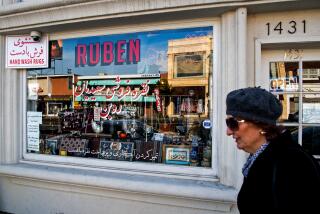ARABS ON TELEVISION: AN UNBALANCED PICTURE
- Share via
You see them on your set. They’re rich. They’re primitive. They’re conniving. They’re TV’s Ay-rabs .
A scene from the syndicated children’s series “Heathcliff”:
An oil-rich sheik arrives in the United States with his harem. He is accompanied by an oil-rich Arab cat who has his own feline harem. The Arab sheik and Arab cat both wear identifiable Arab robes and headdresses.
The Arab cat meets a female American alley cat and falls in love. When he tries to kidnap the American cat, he is beaten up by other American alley cats. Let’s hear it for the red, white and blue.
What have we learned here? That your basic Arab has made a fortune in oil. That your basic Arab male has a harem. That Arab males are so unworthy that non-Arab females reject them, and so uncivilized that they routinely resort to abduction.
End of episode. But not end of stereotypes.
At a critical and tumultuous time when an understanding of Arabs is vital to American interests, narrow, ugly Arab cliches still prevail on TV.
Libyan leader Moammar Kadafi may have become known to most Americans only recently, for example, but junior Kadafis have been occasionally populating TV shows for years as Arab cutthroat villians getting their kicks from menacing the helpless and innocent.
To network entertainment programmers, the only good Arab is usually a bad Arab.
Kadafi’s media shadow is spreading. Witness his recent accessibility to Western reporters and Monday-night interview with Ted Koppel on ABC’s “Nightline.” Outside of newscasts, though, few TV characters are identified as Arab. But when they are? Well, can you recall the last positive depiction of an Arab on TV?
Reversing that obnoxious trend becomes even more difficult when the news is dominated by growing international terrorism attributed by U.S. authorities to Libya, Syria and elements of the Palestine Liberation Organization. The terrorism tends to enforce the stereotype.
No wonder that the Oct. 11 bombing murder of Alex Odeh, regional director of the American-Arab Anti-Discrimination Committee in Santa Ana, received a paucity of national media attention amid the more spectacular Achille Lauro hijacking and murder of Leon Klinghoffer. You almost got the impression that Odeh’s death was less tragic because he died just as he lived--by the sword. In truth, though, he was neither violent nor a terrorist. Very few Arabs are.
“Yet the stereotypes continue in defiance of all evidence,” Jack Shaheen, author of “The TV Arab,” said by telephone from Edwardsville, Ill. Shaheen, who teaches communications at Southern Illinois University, is not dismissing the recent terrorist atrocities at the Rome and Vienna airports. He is merely advocating a more balanced picture of Arabs on TV.
His book, the result of eight years of research, lists four basic myths about Arabs fed by TV: Arabs are obscenely wealthy; they are barbaric; they are sex-lusting and indulge in white slavery; they enjoy terrorism.
“Yet, just a little surface probing reveals that these notions are as false as the assertion that blacks are lazy, Hispanics are dirty, Jews are greedy and Italians are criminals,” writes Shaheen, whose mother was born in Lebanon.
The first time he comprehended TV’s potentially negative impact on kids was one Saturday morning in 1976 when his young son and daughter called him to the set to see the “bad Arabs.” They were watching TV wrestling, where even today unsavory Arab-type characters continue to proliferate as contemptible bad guys.
The author’s long list of prime-time offenders extends even to some of TV’s elite. He recalls a “Cagney & Lacey” story about an oil-rich Arab running over an American Jew with his Rolls-Royce and citing diplomatic immunity while refusing to pay the victim’s hospital bills.
Shaheen remembers Cagney saying to her boss: “You know what ticks me off, inspector? In this guy’s country, you steal a piece of fruit off a cart and they cut your hands off. He comes over here and . . . nearly kills a man. And we can’t even touch him.”
When the two female detectives visit the Arab’s embassy, Cagney feels “like I’m in the middle of the ‘Arabian Nights’ ” and dumps the thick Arabic coffee she is served into a flower pot. Eventually, they get the Arab to pay the bill and donate $500 to the United Jewish Appeal.
“What if the writer had reversed the role of the show’s protagonists . . . ?” Shaheen asks in his book. “Would it be acceptable to telecast a program that shows a rich Jew running down a poor Arab? Would we see the Jew pay the Arab’s hospital bill? And donate $500 to a worthy Arab charity?” And, he wonders, would Cagney throw out bagels as she did Arabic coffee?
Why is American TV so quick to stereotype?
Shaheen asked producer Harve Bennett (“The Six Million Dollar Man,” “The Bionic Woman”) about frequent portrayals of Arab women as belly dancers. “In television, one tends to reach for beach-party bingo sex,” the book quotes Bennett as saying. “When one has the opportunity to show a sexual image without being sexual, you usually seize upon it.” Such a cliche, Bennett added, “saves the writer the ultimate discomfort of having to think.”
Shaheen concluded research for his book in 1984, but continues to monitor TV’s Arab omissions and distortions. Speaking from his campus office, he cited a “Highway to Heaven” white slavery story in which the victims were to be shipped to Tunisia. He cited “Murder With Mirrors,” a CBS movie that, despite having no Arab-related plot, showed a “7-foot Arab emerging from a limo followed by his three dwarf wives.”
Though not optimistic, Shaheen does see a glimmer of light. He gives good marks to Tom Kersey, ABC vice president of broadcast standards and practices, for sensitivity, and says that ABC is now letting him read Arab-related scripts for authenticity. “Some people are accepting the fact that a stereotype exists,” he said. “An awareness is a beginning.”
He claims some input regarding “Harem,” a coming ABC miniseries about a turn-of-the-century white woman who is kidnaped with her fiance in Syria and sold into a Turkish harem. Some people at ABC “thought Turks were Arabs,” Shaheen said, “and the script didn’t mention Arabs when it talked about fighting Turkish oppression.”
Shaheen did see one positive TV portrayal of an Arab family recently, though. Be thankful for small things. It was on “The Smurfs.”
More to Read
The complete guide to home viewing
Get Screen Gab for everything about the TV shows and streaming movies everyone’s talking about.
You may occasionally receive promotional content from the Los Angeles Times.






